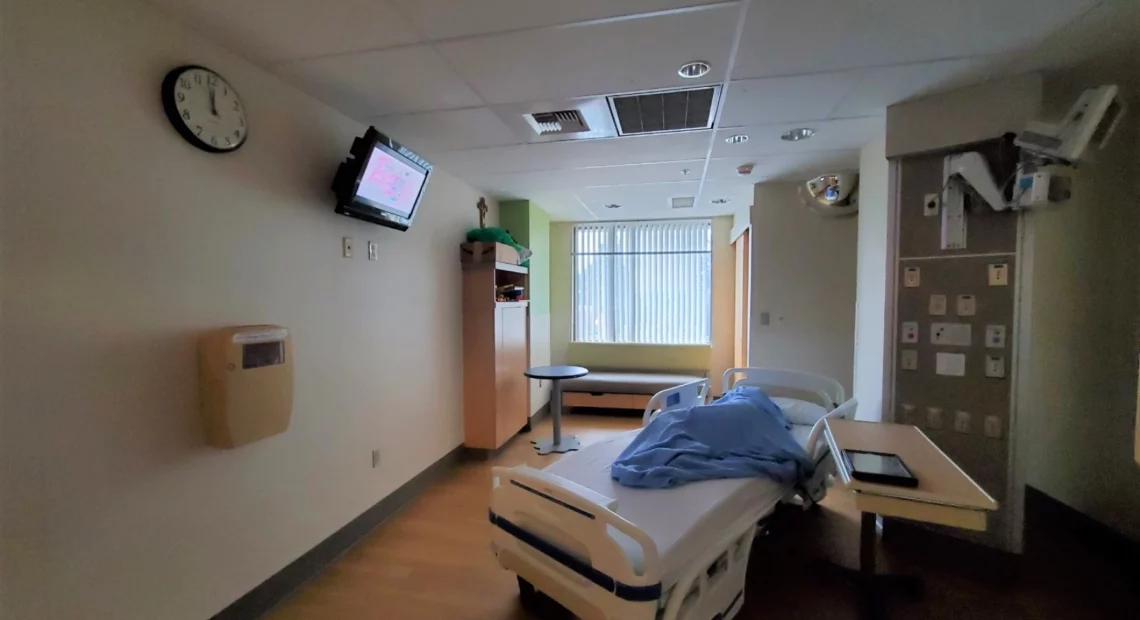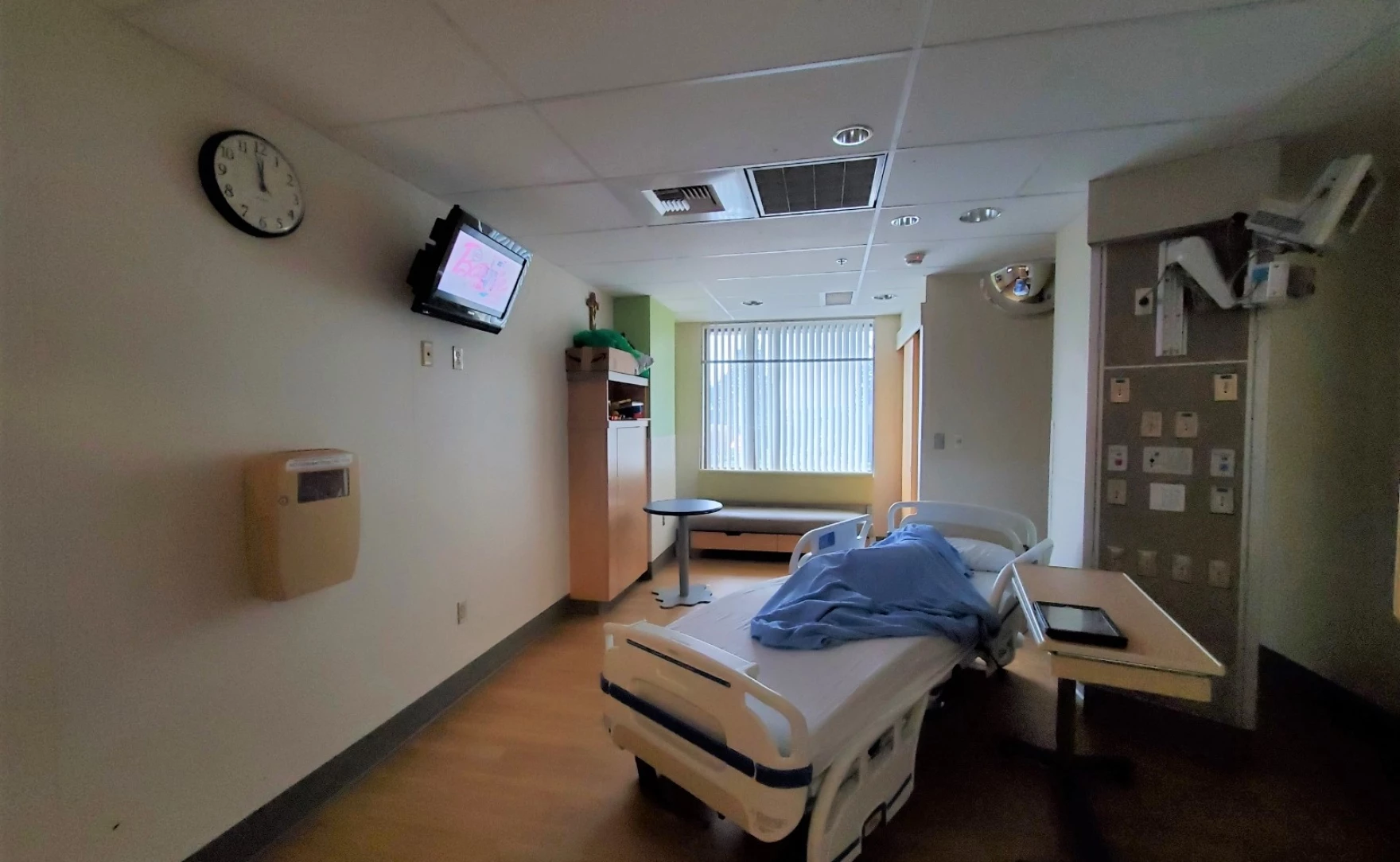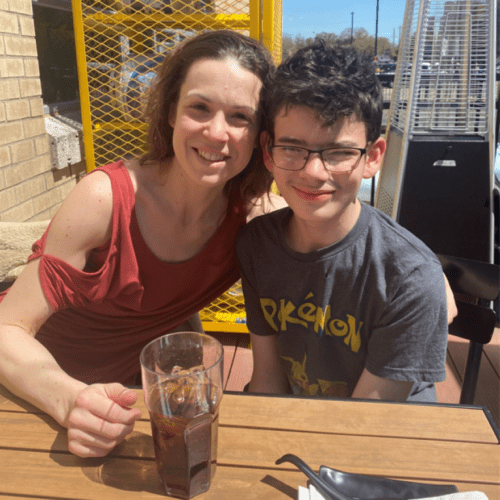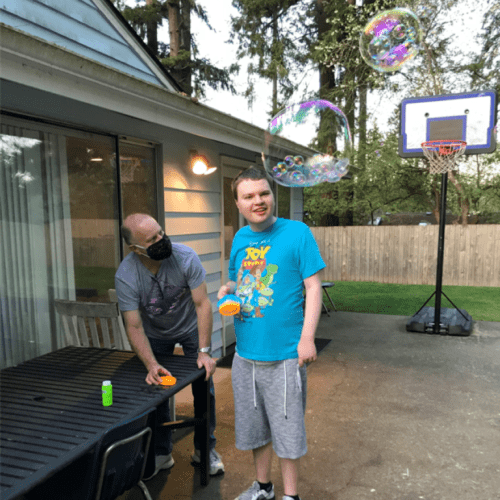In late September, an autistic, non-verbal 13-year-old boy was brought to Providence Regional Medical Center in Everett.
His name was Matthew.
He wasn’t sick. He hadn’t been injured. There was no medical emergency.
Instead, he’d been taken to the hospital after back-to-back incidents in the same day at the group home where he lived. First, he flooded a bathroom. Later, he attacked several staff members who called police to the home.
Nearly three months later, Matthew is still at the hospital in Everett. He spends his days watching SpongeBob Square Pants on TV or viewing music videos on his iPad. Four times a week someone from the school district comes to give him an hour of instruction.
When Matthew gets frustrated, he often acts out. At times, hospital staff have had to physically restrain and even sedate him, according to an advocate who’s working with the family. Hospital officials said restraints are used as a last resort.
His mother says she can’t manage her son’s challenging behaviors at home. And no alternative placement has been found.
The Northwest News Network is not using Matthew’s last name because he’s a minor.
Matthew represents an extreme case of what advocates and state officials say is a growing problem in Washington: youth with developmental disabilities getting stuck in the hospital.
The cases often follow a similar script. The child spirals into crisis and is taken to the hospital. But once they’re stabilized and it’s time for them to be discharged, the state can’t find an appropriate placement for them back in the community. And so, they languish in the hospital — for days, weeks and even months.
“It’s really hard for us to see kids in placements that aren’t appropriate for them,” said Laura Knapp, the director of behavioral health for Providence Northwest, which includes the hospital in Everett. “These kids need an appropriate placement and our beds are prepared for medical need.”
Knapp wouldn’t comment on Matthew’s case specifically, citing patient privacy.
It’s difficult to determine how often kids are getting stuck in the hospital in Washington because there’s no hard data, but anecdotes abound.
“We have seen a significant increase in the amount of kids that … are ‘quote’ stuck,” said Maureen O’Brien, the director of psychiatry and behavioral medicine at Seattle Children’s hospital.
The Washington State Hospital Association (WSHA) said it’s hearing the same thing more broadly from its 100-plus members.
“In the last couple of months, we’ve heard more concern about kids who are getting stuck who have a complexity of needs and there’s not enough services and capacity in our system … to get them the care that they need,” said Zosia Stanley, WSHA’s vice president and associate counsel.
Over the past two months, the state’s Office of Developmental Disabilities Ombuds said it’s worked with nine teens and young adults, ages 13 to 22, who’ve been hospitalized with no medical need, representing a substantial increase in complaints involving this age group.
“One young person spent two months in the emergency room. Two were recently dropped off at the emergency room by their residential service provider. One teen has been in the hospital since January — almost a year,” wrote Betty Schwieterman, the ombuds, in an email.
Attorney Susan Kas at Disability Rights Washington said her organization is also hearing about these cases and “beginning to investigate to understand.”
Washington’s Developmental Disabilities Administration (DDA) doesn’t track how many children are in hospitals awaiting discharge. But the agency said it’s also aware of “a number of cases.”
Gaps in care
In Matthew’s case, his path to the hospital was set in motion in January. That’s when he moved from his mother’s West Seattle home into a DDA-funded group home in Mukilteo for youth with challenging behaviors.
In early September, the group home sent him to Seattle Children’s after he attacked a caregiver. After a few days in the emergency room, he was discharged back to the group home with new medications and a new treatment plan that called for him to receive specialized behavioral therapy.
But his mother said he didn’t receive that therapy and soon after began to act out.
On the day Matthew was taken to the hospital in Everett, he refused to get out of the shower and sprayed water all over the bathroom causing extensive damage throughout his group home, according to an incident report.
Later that same day, Matthew bit, scratched and kicked several staff members in the home after they intervened to keep him from assaulting his housemate. Police were called and when officers responded Matthew again attacked the house supervisor, said the incident report.
That’s when Matthew was taken to the hospital.
His mother found out what had happened when a police officer called her late that night.
“They said that I had to come to the hospital because my son was there and I was the legal guardian and I had to come pick him up,” said the mother, who asked not to be identified for privacy reasons.
Instead of going to get Matthew, she started calling advocacy groups for help.
The Arc of King County, which serves people with intellectual and developmental disabilities, took up Matthew’s case and has been working with his mother ever since to try to find a new community-based placement for him. But progress has been slow.
“He’s there and there doesn’t seem to be a sense of urgency from any of the representatives across these different agencies to find a solution for him,” said executive director Robin Tatsuda.
DDA wouldn’t comment on specific cases, but said efforts are underway to address gaps in the continuum of care.
“Everybody is working to make the system more agile,” said Shaw Seaman, DDA’s compliance chief. “People with autism, especially non-verbal, or in some cases very complex medical conditions, challenge our system for sure.”
Seaman noted that the state budget this year included funding for 12 additional long-term psychiatric treatment beds for youth ages 5 to 17. But getting new beds online takes time.
Meanwhile, demand for psychiatric beds for youth has skyrocketed during the pandemic, creating backlogs in emergency rooms as kids are “boarded” while they await admission to the hospital.
“We’re at [a] full blown crisis of needing more care for kids, because there are so many kids that need support,” said O’Brien of Seattle Children’s hospital.
While many kids in crisis wait for a hospital bed, some parents of kids who are stable and ready to leave the hospital refuse to take their children home. That creates a bottleneck while case managers look for a group home that will take them.
Often when parents refuse to come get their child, Child Protective Services (CPS) is notified.
In the past, CPS would view these as child abandonment cases. But no longer.
“If there is a situation where there are no allegations of child abuse or neglect, those are not appropriate for [CPS] to try to take custody of a child,” said Erik Applebee, a child welfare regional administrator in King County for the Washington Department of Children Youth and Families.
Instead, Applebee said, CPS will try to help connect the family with resources. But he acknowledged the community-based system is stressed and that even his agency struggles to find placements for kids in its care. That’s led to foster youth being placed in hotels and even spending the night in state child welfare offices.
In Matthew’s case, CPS was contacted in early October after doctors deemed him ready to discharge from the hospital. According to a police report of the incident, when CPS refused to take him into protective custody, Providence hospital officials called Everett Police. The responding officer contacted Matthew’s mother who reiterated that she would not come pick up her son “because she does not feel safe around him,” according to a police report of the incident.
Initially, the officer planned to take Matthew into protective custody. But it was later determined Matthew would remain in the hospital and not be discharged. Instead, the officer wrote in his report, hospital officials planned to look for options out of state.
A Providence spokesperson wouldn’t comment on the specifics of Matthew’s case, but said it’s standard protocol in cases like this to contact law enforcement for protective custody once the patient is medically ready to leave the hospital.
Sending kids out of state
Parents of children who are stuck in the hospital due to behavioral challenges often face a gut-wrenching choice: risk bringing their child back home or agree to an out-of-state placement.
That was the predicament Meseret Haile of Bellevue found herself in last fall. Her son, now 14, had been in the Psychiatry and Behavioral Medicine Unit (PBMU) at Seattle Children’s hospital for seven months. Efforts to find him an appropriate placement in the community had failed.
Haile’s son, who’s autistic and non-verbal, had first gone to the hospital after a series of frightening incidents at home. In one case, he’d pushed his father who fell and hit his head on a table and then passed out. Another time, he’d held his mother so tightly she couldn’t breath. His younger sibling had to call the police.
It was a “very, very unsafe situation,” Haile said.
Eventually her son was offered a placement at Heartspring, a residential facility and school for youth with developmental disabilities in Wichita, Kansas. His local school district would pay for the care.
Reluctantly, the family agreed to send him.
“My heart is broken, honestly, still today,” Haile said.
Her son has been in Kansas for more than a year. She visits as often as she can.
“He’s still struggling, but I’m very grateful that he’s safe and he’s being managed by professionals,” Haile said.
Haile’s son is one of 22 children with autism from Washington who are housed at Heartspring, according to Arzu Forough of Washington Autism Alliance. She said another dozen children are at a facility in Utah, and two more are in residential programs on the east coast. Forough described the programs as “boarding schools” for kids on the autism spectrum.
Forough said the fact families have to look out of state is further evidence of a broken system in Washington, which she views as decades in the making. As the state worked to deinstitutionalize people with developmental disabilities, Forough said, it failed to build a full continuum of supports and services.
Before the pandemic, Forough said she would get inquiries about out-of-state placements at most once a month. But now that’s increased to an average of one call a week — including from families whose children are stuck in the hospital.
“We’re waiting in Washington state until it becomes a crisis, and then we’re putting a child in a hospital,” she said.
Forough wants to see Washington create “step-up” and “step-down” facilities, more diversion beds and better training programs for personal care providers. She’d also like to see the therapeutic “boarding school” model come to Washington so parents don’t have to make the hard choice to send their children out of state.
In the near-term, Washington’s current two-year budget has money for four additional state-run residential homes for youth with developmental disabilities. But those won’t be up and running until June 2023. In 2022, DDA will ask the Legislature for funding to build six, three-bed facilities to provide intensive habilitation services and enhanced out-of-home services. In addition, Washington’s Health Care Authority (HCA) is requesting money for two 16-bed residential crisis stabilization facilities.
A loss of supports
Robin Tatsuda with The Arc of King County traces the growing problem of youth stuck in the hospital, in part, to a change in how families access services known as positive behavior supports for their children.
Traditionally, families received these services through DDA. But the federal Centers for Medicare and Medicaid Services (CMS) has told DDA that it can no longer offer behavioral supports and therapies if they are also covered under Apple Health, the state’s Medicaid program.
As a result, families that had been getting these services through DDA are having to switch and get them through their health insurance. The problem, Tatsuda said, is that the managed care organizations that provide Apple Health do not always have adequate provider networks.
“So [families] lost a service from DDA and weren’t able to replace it with anything else,” Tatsuda said.
Without that help, she said, families were more likely to slip into crisis and resort to hospitalization when things got really bad at home.
Seaman, the DDA compliance chief, disputed that narrative and said his agency still offers a “pretty robust menu of services” and works closely with the state’s Medicaid program to address gaps.
“I don’t think you can singularly point to positive behavior supports transitioning out as the causal factor for hospitalization,” Seaman said. “That would be a big stretch.”
HCA, which runs the state’s Medicaid program, said the deadline to change how services for children are billed isn’t until next September, and that it’s working with DDA to “ensure continuity of coverage for client services.”
“Our goal is for no gaps in services for families,” the agency said in an email.
What’s not in dispute is that the COVID-19 pandemic exacerbated existing challenges and laid bare pre-existing gaps in the continuum of care, including a shortage of community-based supports for these complex clients.
Adding to the problem, families with high-needs children were forced to navigate the pandemic largely on their own as schools closed and therapy centers stopped offering in-person services.
“I will tell you this pandemic has only increased the challenges,” Seaman said.
Adults also stuck
The plight of these youth is just the latest chapter in an ongoing saga over how the state of Washington cares for people with developmental disabilities who display challenging behavior issues — like self-injury, aggression, property destruction and elopement.
Three years ago, Washington’s Office of Developmental Disabilities Ombuds issued a report chronicling the alarming trend of adults languishing in hospital beds with no medical reason for being there.
“Some individuals went to the hospital for a medical condition, but when they were ready for discharge, they had no place to go because their residential services provider had terminated their services. Other individuals were dropped off at the hospital by a provider who could no longer manage their care,” the report said.
In one case chronicled by the Northwest News Network, a 46-year-old autistic man named Christopher Davis ultimately spent 15 months in Providence Sacred Heart Medical Center in Spokane. He was outfitted with a special restraint vest designed to keep him in bed and sometimes placed in wrist restraints.
That problem of adults stuck in the hospital hasn’t gone away. At a recent media briefing state hospital leaders said it’s a key factor in Washington’s current hospital bed capacity crisis.
“Our hospitals are bursting at the seams,” said Taya Briley, executive vice president at the Washington State Hospital Association. “But they’re not filled with COVID-19 patients. Remarkably they are filled with patients who do not need hospital care.”
Not all of the patients have developmental disabilities. Some have dementia or have other diagnoses that make them hard to place back in the community.
The situation is putting a strain on emergency rooms. Additionally, non-emergent procedures that require an in-hospital stay are being delayed. Hospital officials say if there’s another wave of COVID-19 hospitalizations driven by the new omicron variant, patients could die from a lack of care.
“If we were able to move these (non-acute) patients out, we would not have to delay procedures and we would have a lot more confidence about handling a COVID-19 surge,” Briley said.
Last August, the hospital association surveyed its members and found that about 10 percent of the state’s acute care beds were occupied by a patient who was ready for discharge.
As of Dec. 8, the Developmental Disabilities Administration said it had 21 clients who were hospitalized and awaiting discharge to a supported living home. The agency said that number has stayed fairly consistent for the past few months.
Last year, the state settled a lawsuit filed by Disability Rights Washington (DRW) and Shawn Murinko, a DDA client, who had been stuck at Harborview Medical Center in Seattle in 2019 following an accident. That agreement, according to a DRW attorney who worked on the case, is focused on preventing disruptions in at-home care for adults with developmental disabilities, which was a factor in people getting stuck in hospitals.
During the 2022 legislative session, hospitals plan to urge state lawmakers to implement a number of other potential solutions to the ongoing problem. They include increasing reimbursement rates to long-term care facilities and speeding up the time it takes to evaluate patients for post-acute care.
A staffing crisis
Any changes will come too late for Charlene Robbins of Auburn. Her 20-year-old daughter Kalena is autistic and has Down syndrome. She’s also nonverbal, blind and in a wheelchair.
Last month, Robbins received a 30-day termination notice from the children’s group home where Kalena had lived since she was 10. The letter said the home was facing a staffing crisis and could no longer care for her Kalena.
Robbins said she was concerned, but also confident that with the help of Kalena’s case manager they could find a new placement. They’d already been discussing where Kalena would go next because she was aging out of the children’s home and needed to move to an adult home.
But five days later, on a Friday, Robbins said she got a call saying the staffing situation had gotten worse and that she needed to come pick-up Kalena by the end of that weekend.
“I was not prepared to appropriately care for her or even come get her, I have nobody to help me lift her or anything,” Robbins said.
When Robbins didn’t come for her daughter, Kalena was taken to a Bellingham hospital. She’s been there ever since.
“She didn’t need to go through this,” Robbins said tearfully during an interview. “And I can’t be there … that’s the saddest part.”
Robbins is hopeful DDA will be able to find an adult group home to take Kalena that’s closer to her home in Auburn — and soon.
“Maybe there will be a Christmas Eve miracle,” Robbins said.
The immediate future is less clear for Matthew who currently spends his days, often bored, in his sparse hospital room in Everett.
Recently, a group home in Spokane agreed to take Matthew. But first staff have to be hired and trained, a process that could take months. There’s also a residential facility in New York state that would take Matthew, but his school district would need to agree to foot the bill.
The Arc of King County, which has been helping in his case, is also exploring whether psychiatric in-patient care could be an option. But the doctors have told them that Matthew is not in psychiatric distress and, even if he were, he wouldn’t be able to participate in the therapy because of the nature of his disability.
A move to one of the state’s four Residential Habilitation Centers for people with developmental disabilities has also been ruled out. They won’t take a 13-year-old.
So, Matthew waits in the hospital. Other than four-times-a-week visits from a paraeducator and a speech pathologist from the school district, his mother said he receives no services or behavior supports. He doesn’t even get to go outside for walks.
On a recent visit to see her son, Matthew’s mother brought him McDonald’s chicken nuggets with spicy sauce. As he ate, she talked about her plans to decorate his room for Christmas with a tree she bought at the dollar store, and the treats she would bring him on Christmas Day.
Matthew’s mother said she continues to feel pressure to take her son home. Providence has also told her that insurance likely won’t cover his stay at the hospital, estimated at $2,800 a day, now that he’s been medically cleared to leave. Still, she insists bringing him home isn’t a viable option.
“I can’t take care of him, he will be out of my house in two minutes, the police will be here and they will place him in the hospital again,” she said.




















